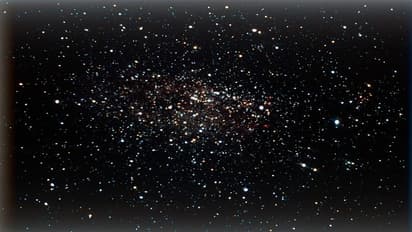Diamond dust to cool Earth? The dazzling $200 trillion plan to combat global warming but there's a huge catch!

Synopsis
Millions of tonnes of diamond dust sprayed into the atmosphere to cool the Earth. What sounds like a futuristic fantasy is now being seriously considered by scientists from the Institute for Atmospheric and Climate Science at ETH Zurich.
A proposal straight out of a sci-fi movie might just hold the key to solving one of humanity’s greatest crises—global warming. Picture this: Millions of tonnes of diamond dust sprayed into the atmosphere to cool the Earth. What sounds like a futuristic fantasy is now being seriously considered by scientists from the Institute for Atmospheric and Climate Science at ETH Zurich.
Their research suggests that diamonds—yes, the world's most coveted gemstone—could be a game-changer when it comes to battling climate change. Unlike previous studies, which zeroed in on sulfur dioxide (SO₂), this team discovered that diamond particles could be far more effective at cooling our planet.
According to their models, dispersing five million tonnes of diamond dust into the stratosphere annually could lower Earth's temperature by a staggering 1.6°C. But such a dazzling solution comes with a jaw-dropping price tag: a projected cost of nearly $200 trillion (£153 trillion) over the course of this century.
This ambitious idea emerges against a backdrop of alarming climate trends. Global greenhouse gas emissions continue to soar, and Earth's temperature is paying the price. Last month was the second-hottest September ever recorded, with the average air temperature reaching 61.1°F (16.17°C). To make matters worse, the first half of 2024 has shattered previous heat records in every single month from January through June.
In the face of this escalating crisis, scientists worldwide are racing to find ways to reverse or at least mitigate the effects of global warming. From capturing greenhouse gases to curbing future emissions, every option is being explored. But in this groundbreaking study, the researchers aimed to assess whether cooling Earth through a technique called stratospheric aerosol injection (SAI) could be a viable solution.
SAI works by spraying particles into the atmosphere that reflect sunlight, thus reducing the heat trapped on Earth. Previous research has focused primarily on injecting sulfur dioxide—a natural occurrence during volcanic eruptions—into the air. However, sulfur dioxide has its own drawbacks, including the potential to cause acid rain, damage the ozone layer, and disrupt weather patterns.
In contrast, the ETH Zurich team explored the effects of six solid particles: diamond, calcite, aluminum, silicon carbide, anatase, and rutile. Their 45-year-long simulation tested how each substance behaved in the atmosphere, assessing its ability to reflect heat, resist clumping, and remain airborne.
The standout performer? Diamond dust. It excelled at reflecting heat while also maintaining its stability in the stratosphere, unlike other materials that tended to clump. And since diamonds are chemically inert, they wouldn’t contribute to acid rain or similar environmental hazards.
"The resulting side-effects on circulation and climate, especially from diamond injections, could be substantially reduced compared to SO₂, making diamond particles most suitable for SAI from an optical properties perspective among the materials investigated here," the researchers stated in their report, published in Geophysical Research Letters.
However, cooling the planet by 1.6°C would require an astronomical amount of diamonds. In an interview with Science, lead author Sandro Vattioni explained that it would take five million tonnes of diamond particles sprayed into the stratosphere each year—an endeavor with a colossal price tag of approximately $200 trillion (£153 trillion). For comparison, that's about 800 times the net worth of Elon Musk, the world's wealthiest individual.
Given the astronomical costs, it’s unlikely we’ll see diamonds raining down anytime soon. But the researchers hope their findings will inspire more studies into alternative materials for stratospheric aerosol injection.
"We suggest further research on agglomeration processes in turbulent aircraft wakes as well as on measurements of optical properties of a variety of potential solid particle materials," the team concluded.
Stay updated with the Breaking News Today and Latest News from across India and around the world. Get real-time updates, in-depth analysis, and comprehensive coverage of India News, World News, Indian Defence News, Kerala News, and Karnataka News. From politics to current affairs, follow every major story as it unfolds. Get real-time updates from IMD on major cities weather forecasts, including Rain alerts, Cyclone warnings, and temperature trends. Download the Asianet News Official App from the Android Play Store and iPhone App Store for accurate and timely news updates anytime, anywhere.